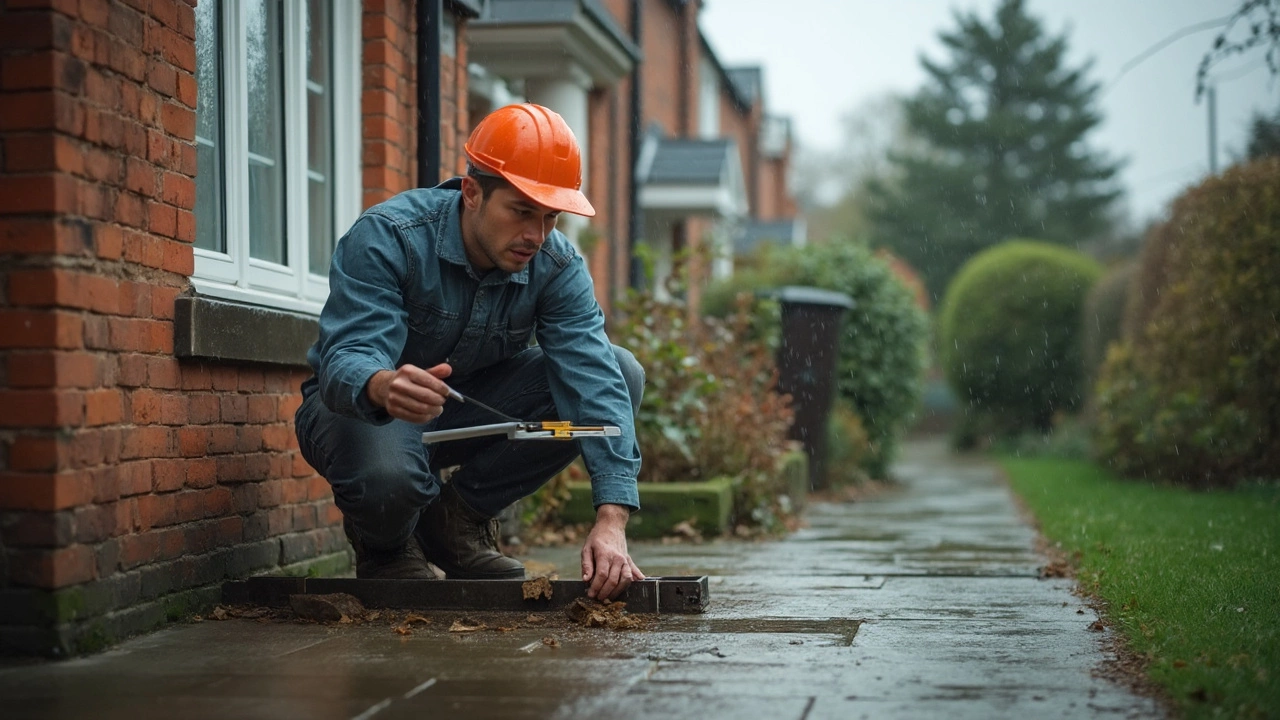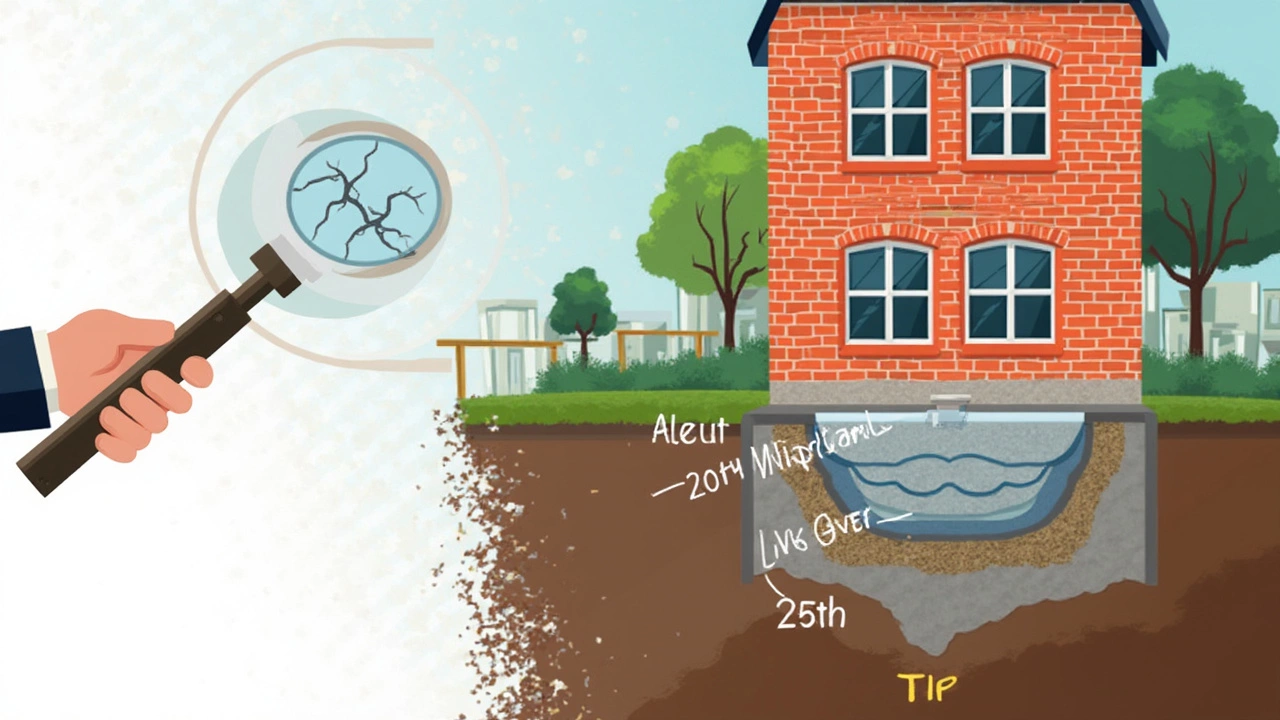Foundation Troubles: Smart Fixes for Your Home's Stability
 Feb, 28 2025
Feb, 28 2025
Ever noticed a crack snaking up your living room wall or a door that's tougher to close than usual? These could be signs of foundation issues lurking beneath your home. Before you start worrying about your house crumbling around you, let's talk solutions that can keep your sanctuary standing tall.
Foundation problems often start small - maybe it's a tiny fissure or a barely noticeable slope in the floor. But if left unchecked, they can snowball into bigger headaches. Catching issues early can save you a heap of trouble and a chunk of change down the line.
Now, not all foundation hiccups require a full-scale intervention. Some can be tackled with DIY savvy and a couple of weekends. Other times, it's best to let the pros handle the heavy lifting. Knowing the difference can make all the difference in maintaining your home's integrity.
- Warning Signs Your Foundation's in Trouble
- DIY Fixes You Can Try at Home
- When to Bring in the Professionals
- Preventing Future Foundation Issues
Warning Signs Your Foundation's in Trouble
Spotting signs of trouble early can save your house from serious foundation repair. Here’s what to watch out for:
Cracks in Walls and Floors
Cracks are sneaky little indicators that something may be off with your foundation. Horizontal cracks often mean trouble, especially if they’re wide enough to fit a dime. Vertical cracks might not always spell doom but keep an eye on them.
Sticky Doors and Windows
We’re not talking about jam from breakfast. If your doors or windows seem to stick or refuse to shut properly, your foundation might be shifting, causing frames to misalign.
Uneven or Sloping Floors
Take a stroll through your house. Feel like you’re on a gentle roller coaster? That’s not normal. Floors that sag or slope could point to issues below.
Gaps Around Windows or Exterior Doors
If you see daylight sneaking through the edges of your doors or windows, or they just look misfit, it’s a clue that the foundation might be off-kilter.
Wet Basement or Crawl Spaces
A soggy basement could mean poor drainage around your home, which sometimes messes with the foundation stability. Watch for water pooling or lingering dampness.
- Cracks wider than a quarter-inch
- Doors or windows that won't latch
- Floors that slope more than an inch in 15 feet
- Noticeable gaps in moldings
Look for Misaligned Molding
Interior and exterior moldings are supposed to line up neatly. If they seem to be separating or sitting unevenly, your foundation may have shifted.
Think your home’s got one of these issues? It might be time to consider structural issues more seriously. Noticing these early means you can fix them before they turn your cozy home into a money pit.
DIY Fixes You Can Try at Home
Got some foundation issues but don't want to break the bank? There are foundation repair tricks you can tackle yourself. Let’s dive into a few basics you can manage with a little elbow grease and some handy tools.
Patch Up Minor Cracks
Those little cracks you see in the walls or foundation might not seem like a big deal, but addressing them early can save you bigger headaches. Grab a tube of concrete patch or filler from your local hardware store.
- Clean the crack thoroughly, making sure there's no dust or loose debris.
- Apply the filler directly into the crack, using a putty knife to smooth it out.
- Let it dry completely before painting over it to match your existing wall or surface.
It's a simple fix that reinforces your home's stability and keeps those cracks from expanding.
Adjusting Saggy Doors
If your doors are sticking or not closing properly, it could be a sign of a slight shift in the foundation. Here's a quick fix:
- Tighten the screws on the hinges or replace them if they're worn out.
- If that doesn't do the trick, consider planing the door to fit its frame better.
These adjustments could make opening and closing doors a breeze again.
Improve Drainage Around Your House
Poor drainage can lead to water pooling around your foundation, causing long-term damage. Check your home's gutters and downspouts:
- Ensure they're not clogged and are directing water away from your house foundation.
- Consider adding extensions or splash blocks to redirect water even further.
A little maintenance can go a long way in preventing water-related structural issues.
Seal Basement Leaks
If your basement tends to get damp or you notice puddles after a rain, sealing those leaks is crucial. Use a waterproof paint or sealant specifically designed for basements. Apply it on walls and the floor to create a moisture barrier and keep the area dry.
Reinforce Bowing Walls
For walls that are starting to bow, carbon fiber strips can be a lifesaver. They're tough and can be installed without much hassle. Just adhere them vertically to the wall, keeping the structure from bowing further.
Tackling these structural issues yourself can help maintain your home's stability without needing heavy repairs. However, if things seem beyond your scope, calling in experts is always the wiser move.

When to Bring in the Professionals
Sometimes, tackling foundation repair on your own isn't enough, and it's crucial to know when it's time to bring in the pros. Major foundation issues can threaten the structural integrity of your home, and that's not something you should risk with a DIY approach.
Signs You Need Professional Help
- Significant Cracks: If you spot horizontal cracks or those wider than a quarter-inch, it's time to call an expert. These can indicate serious settling issues.
- Doors or Windows Misaligned: Doors and windows that won't latch or open smoothly could point to an uneven foundation.
- Water Problems: Standing water or excessive moisture in your basement or crawl space can cause or reveal foundation problems. Professionals use tools like hydraulic jacks and push piers to level your foundation properly.
What To Expect from Professionals
Experts will typically start with a thorough inspection. Many use modern tech like laser levels and moisture meters to assess the problem. Here's an idea of what might be on their agenda:
- Initial Assessment: They’ll diagnose the issue's root cause.
- Detailed Plan: You'll get a detailed repair plan outlining what needs doing and how much it'll cost.
- Execution: Professionals handle everything from minor reinforcements to serious structural interventions, using specialized equipment you won't find at the local hardware store.
As tempting as handling these on your own might be, there's immense value in the expertise only skilled professionals provide. According to data from a 2023 survey, houses with professionally repaired foundations have a higher market value retention, making this investment worthwhile.
By knowing when to call in the experts, you ensure your house remains a safe, secure place rather than a danger zone. Remember, your home is your castle; a stable foundation is its best defense.
Preventing Future Foundation Issues
Stopping foundation problems before they start is way easier than fixing them later. It's about being proactive and keeping tabs on a few key things around your home.
Maintain Consistent Moisture Levels
A biggie for keeping your house foundation steady is ensuring the soil around it doesn't yo-yo between being super dry and swampy wet. During dry spells, give your foundation a nice even watering so the earth doesn't shrink and crack. On the flip side, make sure there's proper drainage when the skies open up. You wouldn't want the soil to swell up and put pressure on your walls.
Keep an Eye on the Landscape
Believe it or not, those gorgeous trees could be drinking up more than their fair share of water, playing a tug-of-war with your foundation. Try to plant new trees a reasonable distance away, and make sure existing roots aren't sneaking too close.
Clever Grading
Your lawn should have a slight slope away from the home. This way, when it rains, water naturally flows away instead of puddling around the base like a moat. It's a simple fix that can do wonders for long-term home improvement.
Regular Check-ups
A little periodic maintenance can catch issues before they snowball. Walk around your house every few months and pay attention to any new cracks or changes. Early detection can stop a minor glitch from turning into a major undertaking.
Data Snapshot: Average Costs of Repairs
Before we wrap things up, let’s take a quick look at potential savings. By preventing issues, you save what often amounts to a hefty repair bill. Here's a glimpse:
| Repair Type | Average Cost (USD) |
|---|---|
| Minor Cracks Repair | $500 - $1,500 |
| Major Foundation Overhaul | $5,000 - $10,000+ |
So, keeping check means keeping cash in your pocket!
By sticking to these practical tips, you'll protect your home from pricey structural issues and keep everything on the level, quite literally!
